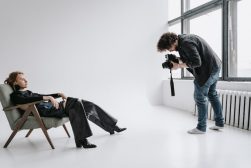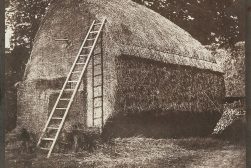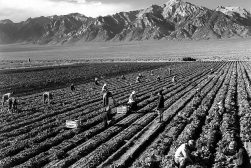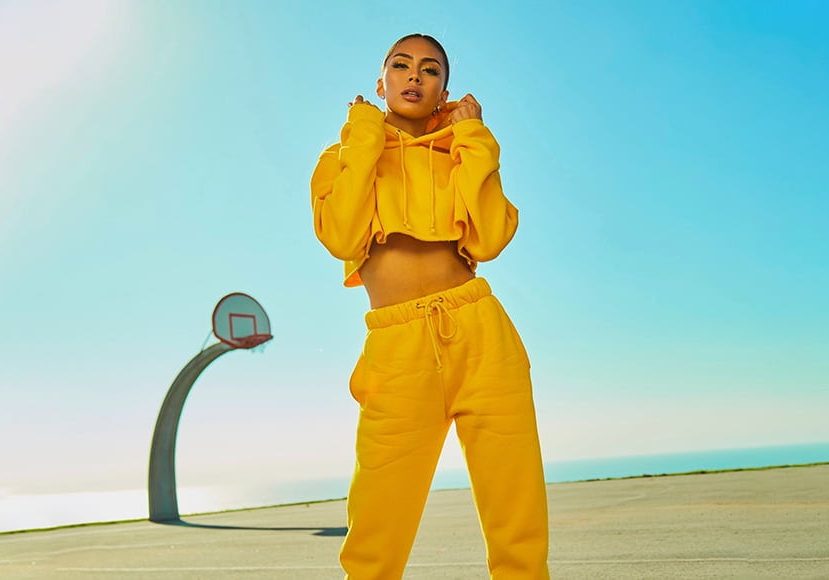
Guide to Fashion Photography
Interested in fashion photography? This guide covers all you need to know, from the different genres to the best tips for becoming a pro!
Learn | Photography Guides | By Ana Mireles
The fashion industry is a multi-billion dollar sector that covers production, design, and sales on many different levels. Most of them make use of photography in one way or another.
When you think about fashion photography, your mind can go from a model walking down the runway to another wearing surreal costumes while trapped in a glass sphere.
Neither one of those images would be wrong. This is one of the biggest and most diverse areas of photography.
That’s why it’s divided into many sub-genres and each one requires different skills, equipment, and budget.
These range from photographing fashion products for ad campaigns to creating high fashion images that are closer to fine art.
In this article, you’ll find an introduction to the vast world of fashion photography.
What is Fashion Photography?
Simply put, it’s a photographic genre that revolves around the world of fashion.
Broadly speaking, fashion photography covers everything from runway shows through to brand catalogs, advertising, model portfolios, editorial shoots, and more.
This diversity means there’s nothing simple about it. Something else to consider is that the fashion genre blurs heavily with other types of photography, including fine art, portraiture, and product photography.
Throughout this article, I’ll try to break it down by defining sub-genres, giving you examples of fashion photographers, and providing you some tips on how to improve your work as a fashion photographer.
What Are the Types of Fashion Photography?
Because it’s such a wide area of photography, it helps to divide the fashion genre into different types. As a fashion photographer, you can focus on doing just one, or many of them.
Each kind has a different scope and that will determine what you need and how you do it. Here are some of the biggest ones.
1. High Fashion Photography
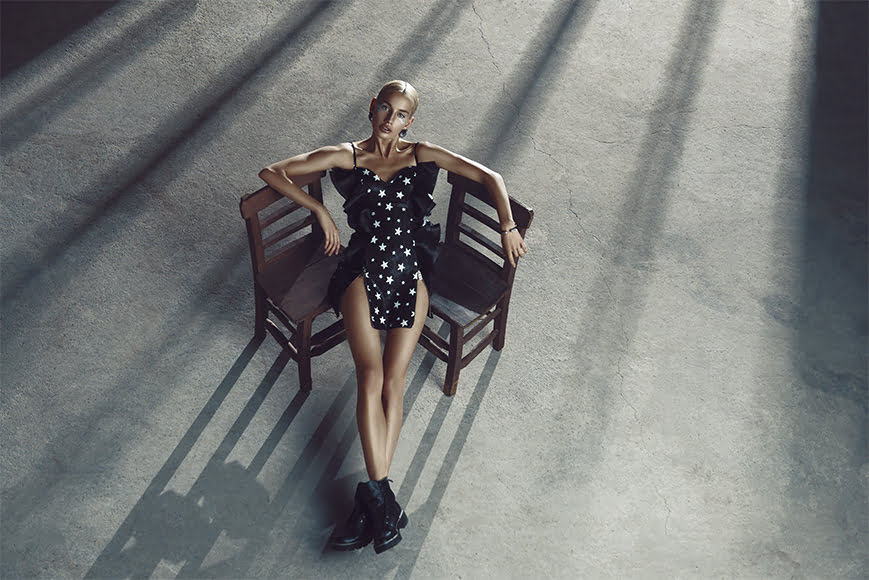
Aesthetics and visual impact are key to high fashion imagery. | Credit: Naeim Jafari
From all the commercial photographic genres that nudge the borderline with art photography, this is the most notorious. Fashion photographers are often showcased in museum exhibitions and are renowned worldwide.
In high fashion photography, you’re not just selling or showcasing the clothes, but also the creative vision and style from fashion houses.
You can leave reality behind and get wild as this type of photography usually needs a big production.
The stars are often top models or famous actors and actresses. The main concept here is to showcase the ideas and skills from all the creative parties involved: the fashion designer, of course, but also the makeup and hairstylists – and don’t forget, your own.
To shoot this type of image you should use a full-frame camera, or even a medium format if possible. This is because they are high budget productions where the quality needs to be the best, no matter the cost.
Often these photographs are printed for fine-art exhibitions or high-end books which also require a high level of detail and resolution to maintain the quality in the print.
Consider this photoshoot as a movie production. It’s not about convincing the average buyer to get this pair of jeans, it’s about showcasing what you’re able to do.
There’s an entire team of professionals that collaborate for the concept to come together and display the final masterpiece.
Because of this, you need to have a good network and team. You’ll probably be working with a complex lighting setup and accessories.
How Much Do You REALLY Know About Photography?! 🤔
Test your photography knowledge with this quick quiz!
See how much you really know about photography...

Last but not least, you’ll need to consider post-production to finish up the look, or add special effects depending on the project.
2. Editorial Fashion Photography
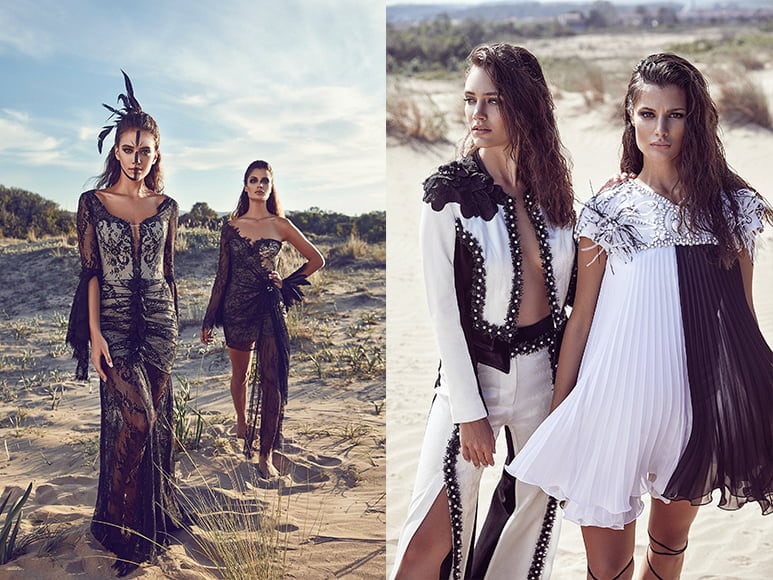
Hair, makeup, and styling are an important part of editorial photography. | Credit: Naeim Jafari
Sometimes editorial is confused with high fashion because of the styling and the production required for the storytelling, but this type of photography is generally more relatable to the viewer.
Editorial can be similar to lifestyle photography, and it’s often aspirational. The model is portraying a role and wearing fashion that you might not use every day but you would like to own.
Editorial fashion photography is so named because it’s featured in books and fashion / photography magazines. Editorial shoots can tell the story of a product or brand, provide a narrative, or illustrate a current trend.
The process before the shoot is important, and you may need to have a meeting with the client to understand what they want you to tell with your photographs – this is called a briefing.
The photoshoots often happen on location instead of a studio and the atmosphere can be very different from one to the other. You need to make sure that they match the mood you want for the story.
If your photographs are taken in the studio, it should be set up with different props and your lighting skills really need to shine. Not because the setting has to be very complex every time, but because it needs to convey a message.
3. Street Fashion Photography
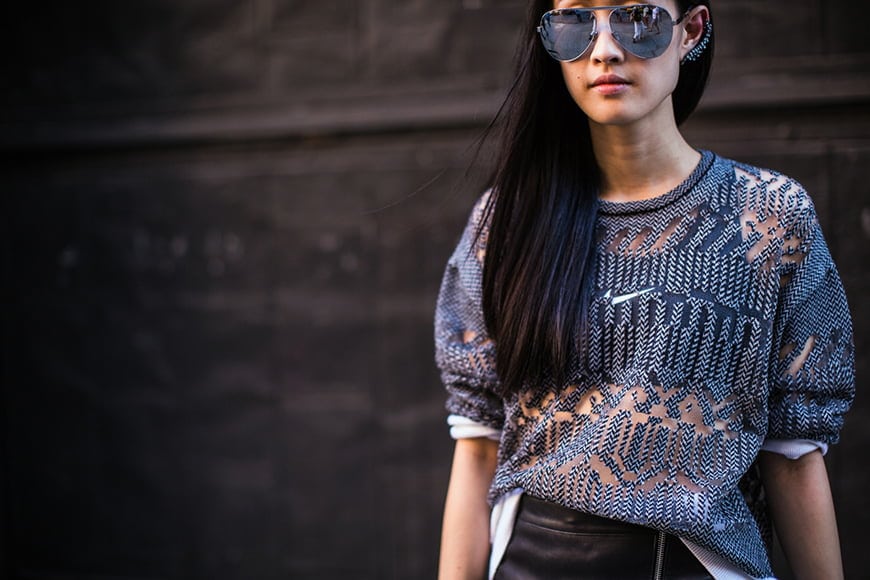
Street style in New York. | Credit: Tania Braukamper
Street fashion photography, also known as street style photography, is all about the real world; what people are wearing and how they’re styling it.
You can see these types of images on Instagram and other social media channels. You can also find them in fashion magazines featuring articles about what is ‘in’ for this season or ‘how to wear x’ guides.
Street fashion photography started out as a sub-genre of street photography, where people would be captured out and about in their everyday lives, with an emphasis on highlighting their unique sense of personal style.
In time, street style became more focused on capturing the outfits worn by the fashion crowd to major events like fashion weeks.
With the subjects becoming aware of the spotlight, they started dressing up especially to catch the eye of the street style photographers, and the genre moved away from being candid to being more posed. Staged, even.
If you’re interested in shooting street fashion photography, decide whether you want to focus on natural, candid shots of real people out in the streets, or the more staged photoshoots that take place outside giving the appearance of happening in everyday life.
Either way, it can be an interesting yet demanding genre to work in.
4. Catalog Fashion Photography
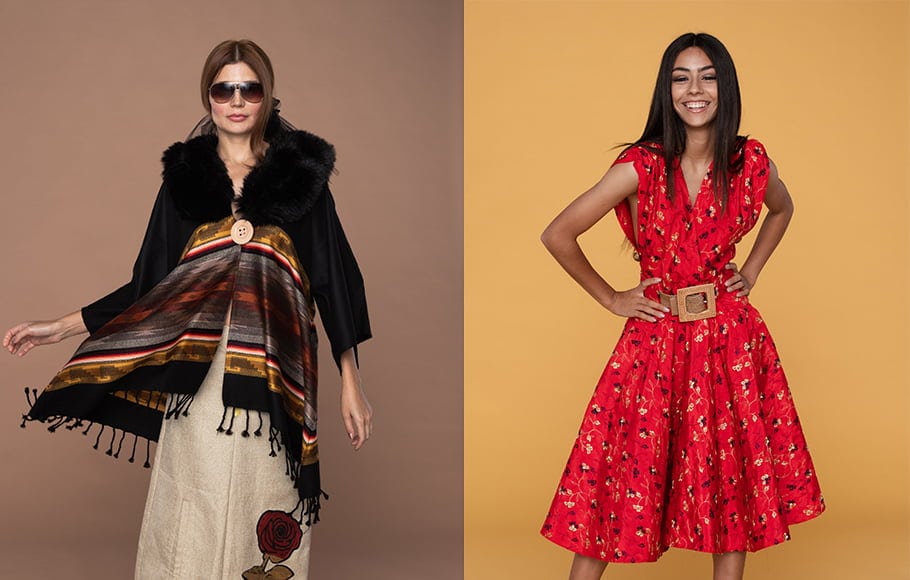
Catalog photographs are all about the products. | Credit: Ussama Azam
Fashion catalog photography is a type of product photography. Its purpose is to show fashion items clearly and attractively so people can get a sense of how they look and fit before they buy.
Usually, the photo shoot is done in a studio with a neutral background. This way there’s nothing distracting your attention from the fashion.
There are different lighting setups already popular for this type of photography. It doesn’t mean that you can’t innovate or have your own style, but there is less creative license for it.
Big softboxes can be very helpful to keep everything well lit and show the details and materials of the clothes.
Avoid using wide-angle lenses that can distort the body. Something between 50mm to 70mm should work out just fine.
Telephotos are ok, but if you need to photograph the entire body you’d need a huge studio, so they become impractical.
The pose becomes quite central in catalog photography because the model doesn’t have props or an action to portray.
You need to communicate clearly with them and create a comfortable atmosphere. Be prepared with different poses that you want; check out many magazines and even Pinterest to get some inspiration.
Pay special attention to the hands as they’re one of the most difficult parts to pose in a way that looks natural.
Simple things can go a long way: for example, have your model with a slightly open mouth as this will make the face look relaxed.
Keep in mind that you’re doing a fashion catalog and not a portrait, so showcase and accentuate the clothes.
If a shirt has a special design on the back, for example, direct the model to turn around and look at you over their shoulder.
5. Runway Fashion Photography
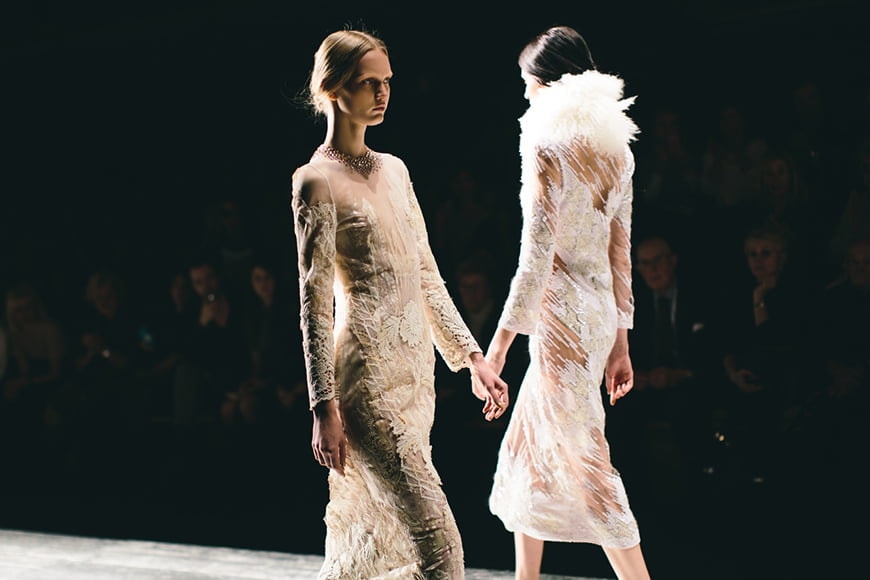
Credit: Tania Braukamper
Many don’t consider this to be a type of fashion photography because it’s closer to a photo reporter documenting an event.
In runway photography, you don’t control the lighting, the setting, or the models – which is why the skillset is very different from any other sub-genre.
You need to be flexible to whatever conditions you find, and be able to think on your feet as this is a fast-paced environment.
Gear wise, you’ll need a very fast lens in order to capture the movement of the models in low light conditions.
The focal length will depend on what you’re shooting, as runway photography can incorporate everything from atmospheric shots to full-length outfits, three-quarter crops, and detail shots of accessories.
Because runway photographers often need to capture a mix of these, zoom lenses are preferable to primes.
Fashion show press pits are notoriously small and packed, so setting up a tripod can be difficult. A monopod can be a great alternative.
Either way, you’ll need some way to stabilize your gear – otherwise, your arms will tire, and you’ll find it near impossible to capture clear shots.
6. Look Book Photography
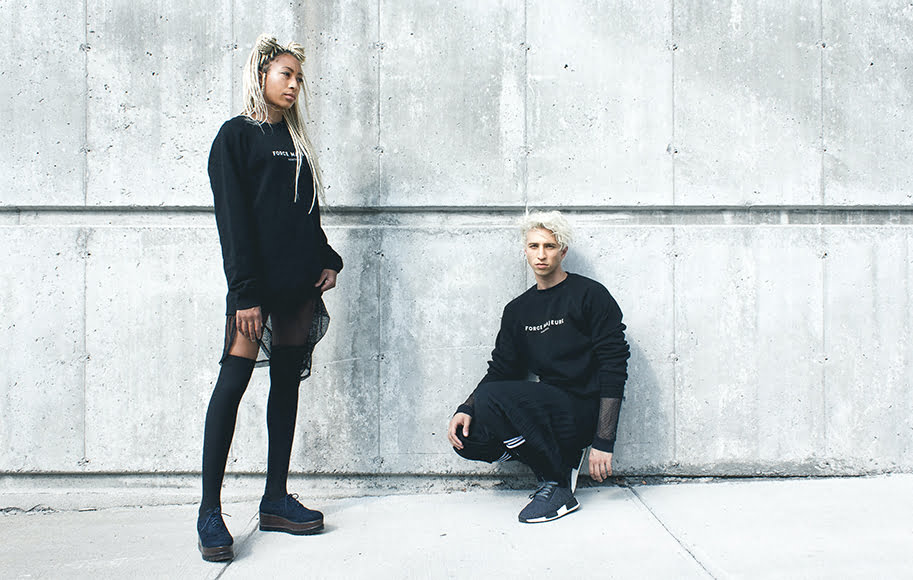
Look books showcase the latest collection of products from a brand or designer. | Credit: Force Majeure
A look book is a small book (nowadays of course it can be digital and interactive) that portrays the latest collection from a designer.
It’s used to present potential buyers (or carriers, when talking about stores) the brand’s new season items.
Look books are different from catalogs in that they display the clothes within a context. Here, the photo shoots are selling each collection together with a concept or an idea.
To do this, the stylist puts together an entire look to sell and the photographer needs to convey the mood and personality of the outfit.
It can be done in the studio with the right props and styling, or you can go on location. There’s no right camera, lens, or settings for this one as there’s a huge variety of look books.
Some brands and designers still do the printed version, especially if they’re from high-end fashion where the quality is important and budget isn’t an issue.
Others make look books only for online use in their websites or e-commerce. The gear that you need depends on the style they’re looking for.
The best way to approach this is to have the first briefing, and then outline a plan of action for it.
7. Advertising Fashion Photography

Advertising images are all about showcasing products like clothing and accessories. | Credit: Tamara Bellis
As with catalog photography, advertising fashion photography treats the clothes and accessories as products.
Fashion ad campaigns may consist of a single image or multiple, and can range from super-simple product shots to intricate shoots featuring top models or celebrities.
No doubt you’ve seen plenty of fashion campaign photographs before – maybe as bus shelter ads, in fashion magazines, or as sponsored posts on Facebook.
How you approach advertising shoots will depend on the client and how they want to convey their brand message.
An ad campaign for a handbag could be a simple shot of the bag against a neutral backdrop, or it could be incorporated into a provocative, envelope-pushing image that gets people talking.
As such, the gear and creative team you need can vary greatly from one campaign to the next.
- See also: Guide to clothing photography
8. Glamour Photography
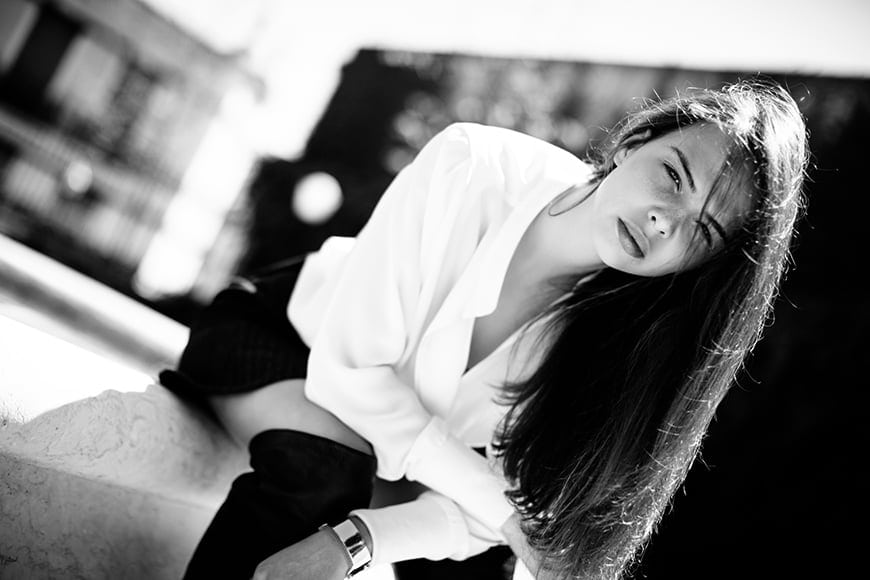
Credit: Tania Braukamper
This type of photography lands in between fashion and portrait photography. It’s all about highlighting the beauty of the model.
The hair, makeup, and styling are not the main focus but they do have to enhance the features of the model. Typically these photoshoots are done as a portfolio for the model to show her versatility.
The session can take place on location or in a studio (or even in a milk bath!), as long as you take control of the lighting. The setup that you choose needs to compliment the model’s attributes. The angle of view is also important to achieve this.
Posing becomes crucial in glamour photography, so make sure that you have some poses in mind beforehand. It can be helpful to bring reference images from a fashion magazine to show the models.
11 Famous Fashion Photographers
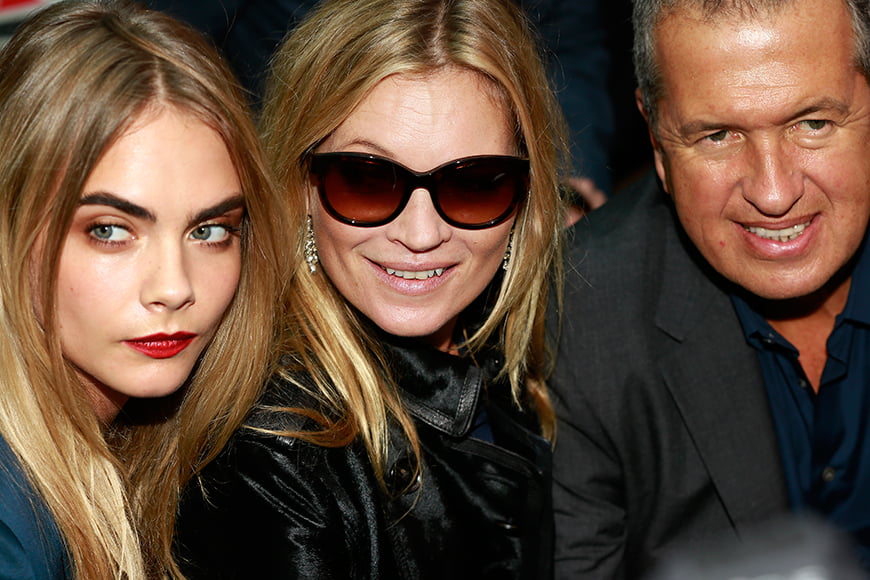
Fashion photographer Mario Testino with supermodels Cara Delevingne and Kate Moss. | Credit: Walterlan Papetti/Wikimedia Commons
The first time someone used photography in fashion was in the court of Napoleon III in the mid-1800s. But it never really thrived until the end of the century and the beginning of the 1900s.
The popularization of this type of photography came through fashion magazines like Vogue and Harper’s Bazaar. The first official fashion photographer was Baron Adolph de Meyer, hired as such by Vogue magazine in 1913.
Since then, there’s been a long list of fashion photographers that are worth mentioning – far too many to explore here.
That’s why this is a shortlist just to pique your interest.
1. Martin Munkácsi – Hungarian photographer, 1896 – 1963.
Many consider him to be the father of fashion photography. Before him, fashion was photographed in a studio setting with models used as mannequins. Then, in 1933, he captured the image that would revolutionize fashion photography making it a dynamic and exciting genre. The famous shot was of Lucile Brokaw running on the beach and was published by Harper’s Bazaar.
2. Helmut Newton – German-Australian photographer, 1920-2004.
One of the biggest authors in fashion photography who turned the genre into art. There have been solo exhibitions of his work in multiple museums around the world. He didn’t need the newest camera nor huge technical equipment; the mark he left in photographic history was based on his creativity and his work was mainly about the model and the location.
3. David LaChapelle – American photographer, 1963.
Contrary to Newton’s style, David LaChapelle creates grandiose productions often inspired by art history. His experience as a video artist helps him to manage complex lighting and set designs, as well as the direction of multiple models.
4. Mario Testino – Peruvian photographer, 1954.
His work has been featured in multiple fashion magazines and he has created the image for many fashion brands. He aims to bring expression and realism into his fashion photographs. He has successfully met the balance between business and art in the fashion scene.
5. Oliviero Toscani – Italian photographer, 1942.
This is a case where the name of the brand and the name of the photographer go hand in hand. The Italian brand Benetton can’t be imagined without thinking of one of his pictures. He challenged all the stereotypes about fashion photography by featuring campaigns that tackled social issues like racism and war. The advertising campaigns he created may have been controversial but they definitely positioned him in the history of fashion photography.
6. Frances McLaughlin-Gill – American photographer, 1919 – 2014.
She was the first female fashion photographer hired by Vogue after winning the Vogue Prix de Paris photo contest in 1943. The dynamics and management of the set and the models moved her work into the theater and later into film.
7. Ellen von Unwerth – German photographer, 1954.
After being a fashion model for ten years, Unwerth decided to get on the other side of the lens. She became a fashion photographer and always portrays her models as strong, self-assured women.
8. Richard Avedon – American photographer, 1923 – 2004.
His work in portrait photography was characteristic because of the emotion captured from his subjects. As a fashion photographer, he worked with famous actors and actresses and became renowned through his work for Dior. His most famous fashion photograph is “Dovima with Elephants” featuring a Dior dress made in 1955.
9. Natalie Lennard A.K.A. Miss Aniela – British Photographer 1986.
She has taken high fashion photography to the surreal world like no other photographer. Her images and compositions turn reality into a dream, with gowns that transform into a flock of birds, or waves that turn into a dress. The award-winning series from Miss Aniela place her in between fine art and contemporary fashion photography.
10. Nick Knight – British photographer, 1958.
Known for his experimental work, he founded SHOWstudio with the idea of showing the “entire creative process, from conception to completion”. He’s listed in the BoF 500 (an index for those who shape the fashion industry). His fashion shoots definitely challenge the ideas of beauty and convention.
11. Zhang Jingna – Chinese-Singaporean photographer, 1988.
She started as a fashion designer with a photography hobby. Later, she decided to become a full-time photographer and made a name for herself from very early on. She does fashion editorial for magazines such as Vogue, Elle, and Harper’s Bazar. She also crossed over to the art world by featuring many solo shows, including Singapore’s first fashion photography street exhibition in 2010.
8 Fashion Photography Tips
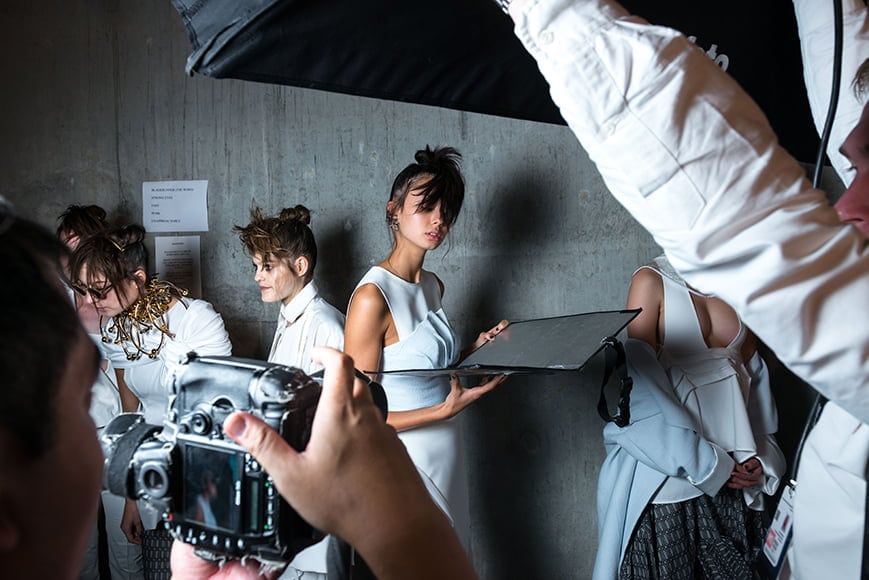
Credit: Flaunter
Some photography tips are related to a specific sub-genre – I’ve mentioned some of those in each category above. Now I want to give you some advice that applies to all fashion photography.
1. Respect the model
It doesn’t matter what type of photography you’re doing, you always need to treat your model with respect.
Sometimes it seems easier to ‘show’ your model what you mean by grabbing them, but you should never touch her or him without asking first.
It doesn’t have to be a rough interaction for it to be uncomfortable and unprofessional. Even placing your hands on their shoulders to rotate them a few degrees is intruding into their personal space.
Start by explaining and communicating what you have in mind. Another more visual solution is to put yourself in the position to demonstrate exactly what it is you want.
If none of these techniques work, ask the model for permission to touch them.
2. Communication is key
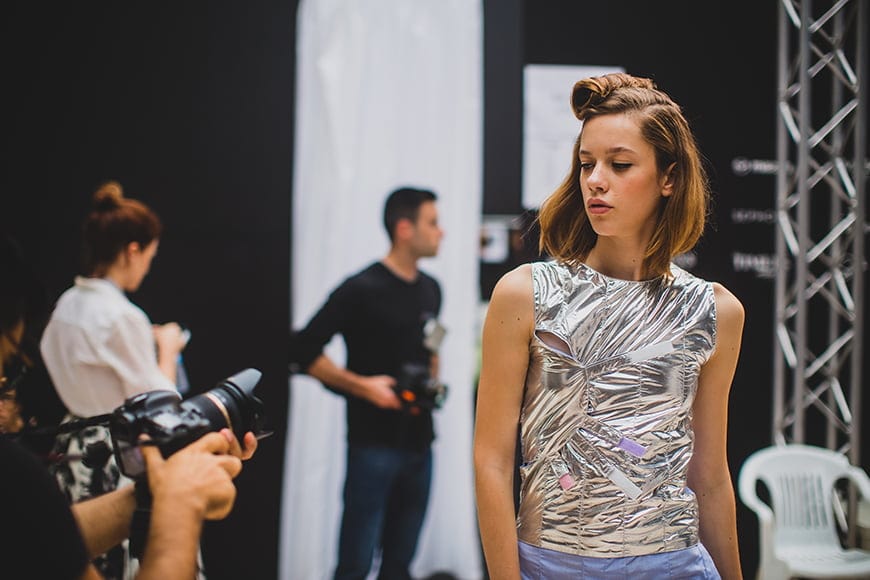
Credit: Tania Braukamper
Fashion photography in almost all of its forms is a team effort. To begin with, the model should always be clear on what is expected with everything from acceptable fashion poses (see guide) to the theme of the shoot.
The designer, hairstylist, makeup artist, and all other members of the team need to be on the same page. Before the shoot, each one should be able to do their work and make sure their part is ready.
As the photographer, you are in charge of coordinating everyone so that the final image is what you set out to create.
3. Get releases
Licenses, permits, and copyright agreements are very complicated things. From model releases to designer contracts, you should always be covered.
The model release is the most common type of permit. It states that they agree to be photographed and then published.
This can be very elaborate – e.g. outlining specific uses for the photographs during a limited period of time – or very simple and generic.
It’s important to sort out your releases and agreements from the outset.
Note that not only models need to sign a release – anything that shows in your picture that is subject to copyright should be explicitly permitted by the owner’s right.
For example, if you’re doing a photoshoot where a famous skyscraper is in the background, you may also need permission from the architect.
If you’re doing the photos for a magazine or the model and not for the fashion brand itself, then you may need to get their permission to use their clothes in your photographs.
If you’re not sure, it’s always better to be on the safe side and get legal advice.
4. Stay updated
The first thing you have to do is learn about camera settings, lights, how to pose, etc. But once you know the basics, you need to keep learning what’s in.
You should never assume that whatever successful pictures you did before will continue to be good tomorrow.
Fashion is a fast-paced industry and trends continuously change. The photographic principles will be the same but they need to be applied in new and exciting ways.
Stay up to date with lighting techniques, post-processing styles, even the changing poses of the models.
Some of the ‘unnatural’ poses that appear in fashion photography today were unthinkable in the past. There’s even an Instagram account that features these images with irony and humor called “Modelos con ciática” (literally translates to models with sciatica).
Speaking of which, Instagram and Pinterest are a bottomless pit of inspiration. They’re a great way to stay updated as to what’s ‘in’.
Follow all the big brands and magazines but also look for the models’ accounts that will showcase their latest works and portfolios.
Look for some of the many curated accounts that scout the Internet for the best images, saving you a lot of the work.
And don’t underestimate the printed media. Yes, we live in a digital age but picking up a fashion magazine can still be a great way to find inspiration instead of getting lost in a sea of images.
5. Renew your portfolio
Continuing with the idea of staying updated, your portfolio is something that you should definitely renew often.
It’s easy to think that a portfolio should show your history. Tell the client that you’ve been in the business for a long time and this should give them confidence.
But beyond that, remember that styles change – not just in fashion but also in photography.
To sell your work to potential clients, they need to see what you can do and how their brand will be represented in your images.
If they see photos that look old or out of style, they won’t give you the job. To show your trajectory as a photographer or get more in-depth about what you’ve done, use your website.
In your physical photography portfolio, keep it short and keep it trendy.
6. Don’t obsess about the gear
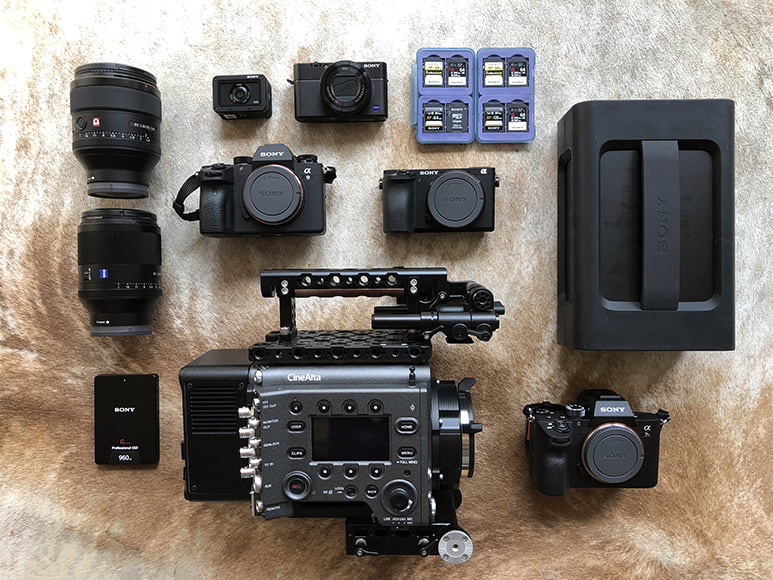
Whether high fashion or street fashion photography, your gear will depend on your style of shooting. | Credit: Jeff Berlin
Having the basic equipment is great for you to start making your way into the business. It will give you the independence to make photo sessions on your own to find your style and keep practicing.
Also, it will allow you to stay in budget for a variety of assignments. However, you shouldn’t be conditioned by that when you want to experiment or even try to land a new client.
It’s almost impossible to have everything you might need for every possible job (unless you happen to be extremely rich!). Truth is, you can rent gear according to your needs for a specific photoshoot.
After the briefing with the client, you can make a plan of action and see what you’re going to need. If you need a bigger studio, a medium format camera, an extra set of lights… make a list and include the rental prices in the budget.
Just make sure that you consider everything you need before you send your quotation. Otherwise, you might end up losing money instead of earning.
7. Be a good team player
Fashion photography is not a one-man show. You need to have strong people skills to get the job done.
If you’re a beginner or if you come from another photography background, it can be difficult to adapt because of the number of people involved in the photoshoot.
You might be ready to go with your lighting, composition, posing, etc, and right before you press the shutter button someone stops you because the hair of the model needs to be adjusted.
This can be frustrating at times but it’s important to keep in mind that everyone’s work is what makes a fashion photo a success.
As a photographer, you need to be able to delegate, coordinate, create a good working environment, and deliver a high-quality picture.
It’s not an easy task and it’s not achieved overnight. If you have the opportunity to work as an assistant, be attentive to how it’s done.
And most importantly, always learn from your experiences and be open to feedback.
8. Practice
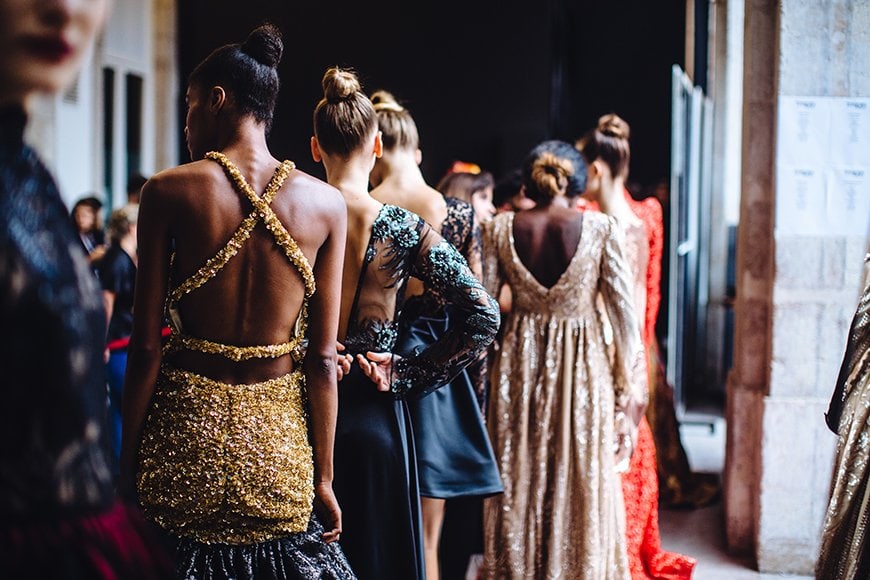
Find as many opportunities as you can to practice your craft. | Credit: Tania Braukamper
As you can see, there are many ways to approach fashion photography, so you don’t have to wait for the next big client to make a fashion shoot.
In between jobs you can keep practicing and experimenting even with a low budget. You might not be able to do a high fashion production every day, but you can do look books, or attend fashion shows.
Fashion Photography FAQs
How do you become a fashion photographer?
Master your basic photography skills first. Then go out and start practicing: you can use friends as models to begin with, then move on to inexperienced models looking to build their portfolios. As your experience grows, develop your personal style and work out what type of fashion photography you want to specialize in.
How much money does a fashion photographer make?
According to ZipRecruiter, the average annual salary in the US is $41,354. However, there’s potential to earn a lot more depending on your experience level and how successful you become. See more about photographers’ salaries here.
How do you plan a fashion photoshoot?
First, decide on your concept and create a mood board. Put together your team – models, stylists, hair and makeup – and work out any necessary agreements and release forms. Scout for a location that fits your concept. You’ll also need to arrange the clothing samples, and any accessories and props.
Final Words
I hope you enjoyed this article and found some inspiration, clarified your ideas, and got excited about trying your hand at fashion photography.
I know it can be overwhelming because of all the possibilities, but the good thing about it is that you have many choices to find your own way.
It’s really important to network, so don’t limit yourself to reaching out to clients. Contact stylists, models, retouchers, artists, and basically anyone whose work you admire – Model Mayhem is a good starting place. Build a strong team, and head out to photograph.

Check out these 8 essential tools to help you succeed as a professional photographer.
Includes limited-time discounts.





